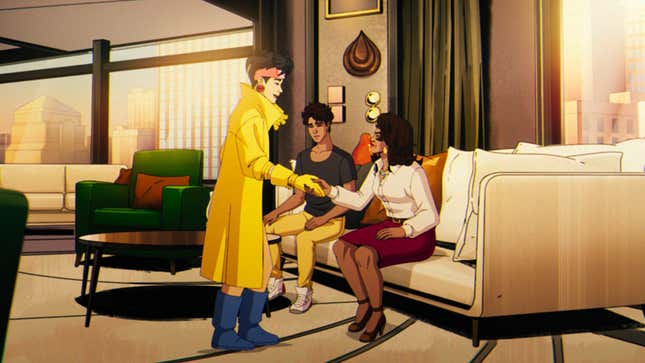Why Did It Take 30 Years for a Latino Character To Join the Core X-Men on TV?

Sunspot, also known as Roberto “Bobby” da Costa, is not only hot, rich, and single; he’s also the first Latino character to be a core part of a televised X-Men team. It only took 30 years for an X-Men team to on the small screen to make a Latinx character one of the main members. That’s correct: This super-powered group that is known for diversity and inclusion did not have a core Latino mutant until the fantastic animated series X-Men ’97 premiered in 2024. Not great.
Yes, Roberto da Costa and Amara Aquilla, a.k.a. Magma, were featured in X-Men Evolution, but they were a subgroup of the X-Men team, the New Mutants, and the two characters didn’t really contribute to the overall story. A quick search of the Roberto da Costa Fandom page will show that he appeared in 22 episodes but only had lines in three. So his drop-ins in X-Men Evolution felt more like filling in a diversity quota than developing an essential character to the story. (I said what I said.)
The crazy part is the lack of Latino representation in media is not new. According to its 2016 report on inclusion and invisibility by USC’s Annenberg Inclusion Initiative, Latino/Hispanic identifying characters with speaking roles only made up 5.1 percent of characters represented out of a sample of 414 stories from film and television.
And in Annenberg’s most recent study focused on film, released in 2023, we see those numbers haven’t really changed since the mid-2010s. It shows Latino characters only make up 5.5 percent of speaking characters. All this information is crazy given that Latinos are the fastest-growing population according to U.S. Census data. In the 2020 census, the U.S. Hispanic population reached 62.1 million people, making Latinos the second largest racial or ethnic group behind white Americans. And yet, they’re still one of the least represented groups in film and television.
But I digress. Back to Sunspot. In X-Men ’97, the character not only has lines but he also has a story and somewhere to grow. And the fact that he has meaningful dialogue here is leaps and bounds from where we were before.
If you’re new to comics and only know the X-Men from animated series, here’s a bit of background: Sunspot has been around for quite a while. Roberto da Costa first came on the scene in Marvel Graphic Novel #4, The New Mutants, in September 1982. He’s a mixed-race Afro-Brazilian character whose mother is white and whose father is Brazilian. In the comics, da Costa is described as a hotheaded rich playboy who eventually inherits his dad’s empire, as well as a mastermind of using both soft and hard power to achieve his goals.

Jubilee (voiced by Holly Chou), Roberto da Costa (voiced by Gui Agustini), and Nina da Costa (voiced by Christine Uhebe) in X-Men ’97
Image: Courtesy of Marvel Animation
The actor voicing Sunspot in X-Men ’97, Gui Agustini, is also a mixed-race Brazilian. Agustini’s father is Peruvian and his mother is Argentinian. Growing up in Brazil, Agustini only ever saw the X-Men in Portuguese. In an interview with The A.V. Club, the actor says he always saw the show as an American show. And because the show was exported to Brazil, he never thought about the lack of Latino representation.
Fast-forward to Agustini now in the United States. The actor says he wasn’t “expecting” the support he has received playing the character, not to mention all of the comments about the importance of representation that the role has sparked. “The impact has been having people write to me on Instagram,” he says. “Or when I meet people, they say how much it means to them that they’re, you know, feeling represented and they’re seeing themselves in a way.”
Agustini goes on to note he feels it’s a “great honor” to represent the Latino community and Brazil. “As I was recording it, I never really—I don’t know—realized it was going to be this big, you know? it would have so much of this kind of impact.”
X-Men ’97, which runs through May 15 on Disney+, is constantly trending on social media—and for good reason. Every episode has featured all of the core characters and given them depth and a trajectory for them to grow.
So, while executives are basking in the success of this show, they should remember why X-Men ’97 is resonating. The series has great writing, sure, but it also boasts a sense of feeling seen for viewers, offering a diverse cast of characters that they can be emotionally invested in and relate to.
And that representation on the show doesn’t stop with Sunspot. Personally, I think the end of episode eight is a great setup to introduce a badass Latina character, Dr. Cecilia Reyes. As we move on towards the ending of season one, let’s hope the show continues to try to accurately reflect America, a country made up of many different races, backgrounds, and ethnicities, Latino being just one of them.
